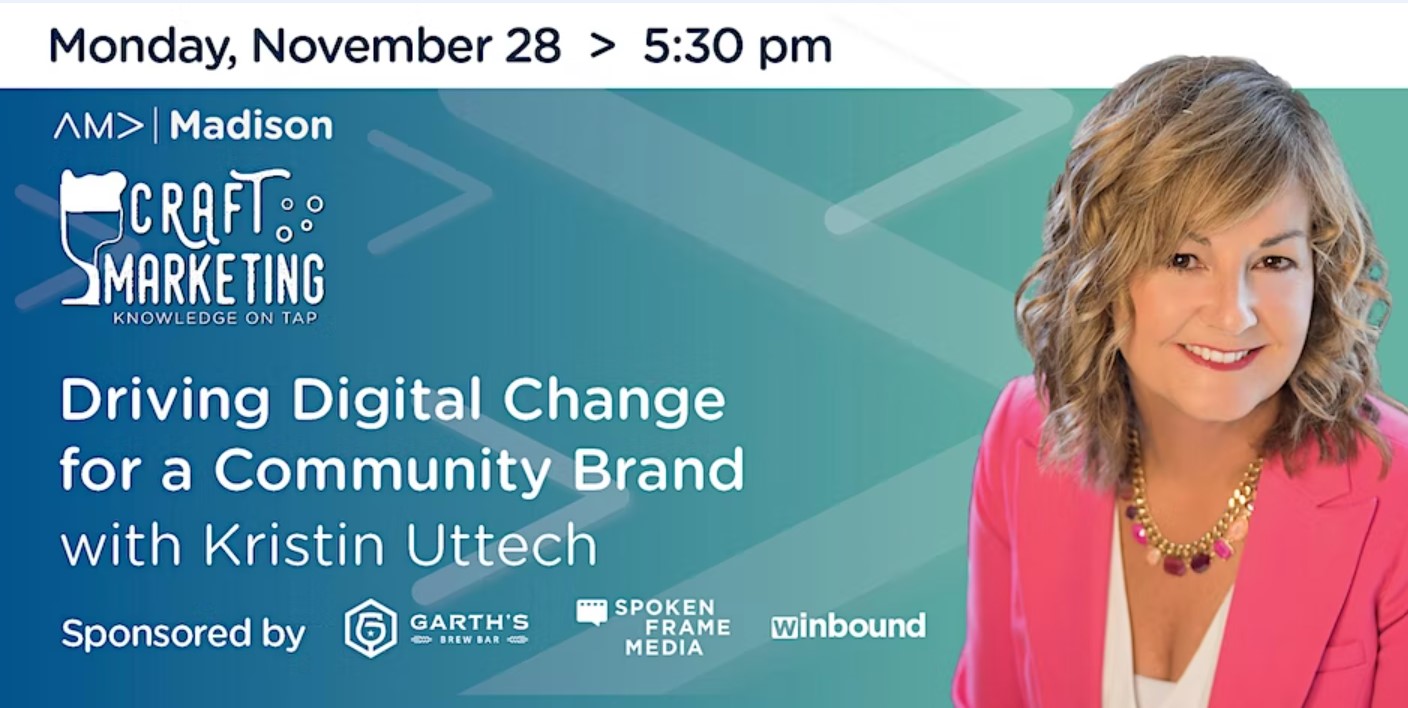No matter what your company’s vision for the future is, it must involve digital transformation. Evolving your processes from “what we’ve always done” to “how we can be better” is key to growth, success, and retaining your customers. Regardless of your industry or size, it’s disrupt or be disrupted.
Kristin Uttech understood the urgency of digital transformation. As the head of Marketing at Madison College, she has led the charge to drive digital change in recent years and has seen meaningful results.
But change isn’t easy. For change leaders, it means navigating broken processes and resistance from all angles. And for employees, it means reimagining their work lives, which can lead to uncertainty and fear. That’s why Kristin joined AMA Madison’s Craft Marketing event on November 28th – to guide marketers through digital transformation, step by step.
Read on to uncover the seven keys to delivering a successful digital transformation, plus get Kristin’s top takeaways from her experience.
6 Keys to Successful Digital Transformation
1. Define Your Goals & Understand Your Current State
Before you can drive meaningful, sustainable digital change, you must define your goals and understand your organization’s current state.
No two digital transformations look the same, so it’s essential to define what you want yours to achieve. Go back to basics: revisit your organization’s core values and mission statements, and connect them with your overarching goal. For example, Madison College aims to help people from all walks of life foster life-long learning and success through top-quality higher education, with an emphasis on uplifting underserved communities. Kristin and her team knew that their college had a lot to offer, having grown beyond strictly technical and vocational programs to encompass 200+ programs across industries. Madison College also proudly stands as one of the biggest onramps to UW-Madison, and is a major destination for UW-Madison grads looking for new career prospects.
The value was there. The goal was to make potential students aware of this.
With your overarching vision for your transformation, it’s time to investigate your current state. Examine your current processes carefully and look for what is and isn’t working. Next, define your core challenges and put them into context with your industry and competitors. For Madison College, these hurdles included:
-
- Process-driven. Higher education institutions often limit themselves by strictly adhering to processes that make sense internally without considering what may benefit the student.
- Silos. Silos were a massive problem across the college, particularly poor communication within teams.
- No analytics. The team didn’t know what was working and what wasn’t. Instead, they relied solely on gut feeling.
- Lost leads. Without a lead-capturing strategy, leads would come in and collect dust.
- Team culture. As Kristin learned, enacting change within cultures is extremely difficult and takes time.
- Strategy. They lacked a consistent strategy that pointed everyone in the same direction.
- Pivoting with COVID-19. As a hands-on college, it was a massive challenge to move 22 classes online and support their students, many of whom had lost jobs, faced child care shortages, worked on the front lines in healthcare, struggled to pay the bills, and lacked sufficient technology to learn. The college directed much of their federal aid to help their students, but it was clear that broader change was needed to thrive in a rapidly evolving world.
And they weren’t alone in these struggles. These challenges applied broadly across the higher education landscape. Madison College needed to get creative to remain competitive in its industry.
2. Transform Your Culture
Kristin explained that transformation happens when you get the right people in place, as you can’t do it alone. However, the tough reality is that you can’t execute your digital transformation strategy with team members who aren’t on board. You’ll need to address your culture to convince your team that transformation is a strategic imperative they should embrace.
To combat resistance, clearly define why you’re pursuing digital transformation and what results it is projected to bring. Additionally, explain how it will impact each employee’s daily work life and how you plan to address training if new skillsets are needed post-transformation. It’s also critical to keep an open dialogue. Encourage your staff to provide feedback and ask questions throughout your digital transformation journey.
From Kristin’s experience, changing one’s culture is the toughest thing to impact as a leader. However, she found success in methods including:
- Becoming more engaged by moving her desk out of her office and onto the floor among her team. This way, she could be more approachable and present throughout the process.
- Establishing behavior guidelines based on values by sitting everyone down and asking questions like “Who do we want to be?” and “Which values will we lead with as we interact as a team?” Additionally, you’ll want to set defined processes to standardize projects.
- Prioritize accountability for projects as well as general behavior. When a project doesn’t follow the agreed-upon process, address it. The same goes for coworker interactions that go against your set values.
- Use data to convert skeptics. Data is a strong persuasion tool, whether it’s your executives or your team.
3. “Sell Up” Your Digital Transformation Vision
Digital transformation doesn’t exist in a vacuum. It needs funding to get off the ground. That’s why a primary function of your job as a digital change driver is selling up your transformation vision. To gain partnerships across the college, Kristin and her team drew up a strategy umbrella that presented their overarching digital marketing plan. They also presented as much data as possible to back up their plan’s details. Doing so shows that you know what you’re talking about and gives them a preview of the projected results.
4. Collect Data & Put It Into Action
You’ll never know how successful your digital transformation is if you don’t establish and regularly measure key performance metrics (KPIs). Madison College now has metrics in place and utilizes analytics, with application growth being the main measurement. They’ve also begun capturing leads and have built a comprehensive lead-tracking program for their recruiters. As a result, following up on leads has become a massive part of their strategy. Kristin also cautions marketers to think twice before pursuing a marketing vehicle that can’t be measured. For example, outdoor advertising is a powerful way to increase brand awareness. Still, you can’t track how many views it gets or how viewers behave after seeing it. It doesn’t mean it’s not worth doing, but it’s important to consider these downsides.
Search engine optimization (SEO) is a powerful way to meet your audience where they’re at. As Kristin found, the results can be surprising. In her research, she discovered that many people in her target audience were searching “cheap college.” Initially, she got pushback on the prospects of optimizing using these simple terms, but she had the data to back it up. To ensure the quality of Madison College’s SEO efforts, Kristin appointed a search engine strategy person, who became a core member of her web team.
5. Craft Your Messaging Strategy
As your organization undergoes all the changes you have planned, your messaging strategy will need a transformation of its own. But to ensure your messaging lands, you must first have a deep understanding of your audience. Instead, Kristin and her team accomplished this by leading focus groups and then building marketing personas. They created 12 personas, one to represent each of the programs offered, and focused on motivations, behaviors, concerns, and reservations. With the help of their media buying partner, they even narrowed down where their audience members received information.
In its pursuit to reinvent its brand via strategic messaging, Madison College was determined to stand out. Specifically, they wanted to avoid the cliche trope in higher education of showing images of students sitting on a couch holding a laptop. Kristin and her team settled on the messaging focus of centering their value statement around what their potential students need and want. This empathetic approach aimed to show students that they’re seen, heard, valued, and that Madison College can help them. Their focus group data became invaluable, as did their marketing personas. They ended up putting this idea into a successful ad campaign.
6. Redefine Your Digital Strategy
First impressions are everything when it comes to your potential leads. That’s why redefining your website strategy and website itself is such a huge part of digital transformation. Kristin emphasized the importance of owning the leadership regarding your web strategy. Like so many others, Madison College’s website ownership fell under the category of “No one owns it, and everyone owns it.” Centralizing your web strategy efforts will increase your website’s cohesion, effectiveness, and overall organization.
Your website strategy focus will depend greatly on the sentiments you received in your focus groups. In their discussions with students, Kristin and her team realized that their existing website displayed too much information in one place, leading to confusion and frustration. They solved this problem by creating three websites to serve their different audiences’ needs. Kristin explained that this plan allowed them to build a web experience that centers the needs and desires of students, rather than centering the logic of internal processes, as their previous site had.
To tackle this core component of digital transformation, Madison College broke its web redesign project into three phases:
- Phase 1: Future Student Web Redesign, which targeted their recruitment goal.
- Phase 2: Current Student Web Redesign, which targeted their engagement goal.
- Phase 3: Madison College Multi-Site Model Strategy, which targeted their alignment goal.
Beyond your website strategy, it’s important to rethink your social strategy as well. Look at what’s working, what isn’t, and consider where your audience can be found most often. Meet them where they’re at. Kristin acknowledged that while it can be difficult to imagine your brand on TikTok, it may be worth the effort if your audience lives there. Her team has experimented with TikTok and has seen some posts take off.
Kristin’s Top Takeaways for Digital Transformation
- Start at the foundation of your organization.
- Know the right battles to fight.
- Get the right team, a group of people who are motivated and ready to come along for the ride.
- Share the vision and strategy across your organization.
- Listen to your team, other departments, and your customers.
- Leaders don’t always have the best idea.
- Research, measure, and use the data you find to drive better decisions and win over resistant individuals.
- Be nimble.
- Empower your team to take risks and try new ideas out, and let them know you’ll protect them if failure results.
See You at Garth’s Brew Bar for December’s Craft Marketing
Craft Marketing invites you to its next live in-person event at Garth’s Brew Bar in Madison at 5:00 PM on December 12th, for the Ugly Sweater Craft Marketing Mixer. In this holiday edition of Craft Marketing, we will network, enjoy craft beer, and spread some holiday cheer.
Register here for the in-person event.
Thanks to our sponsor:
 About the Author
About the Author
Kara Martin, Content Writer at Naviant, specializes in written B2B content, from case studies to blogs and beyond. She transforms complex technical information into compelling, data-driven content that helps organizations turn their digital transformation goals into a reality.



 About the Author
About the Author